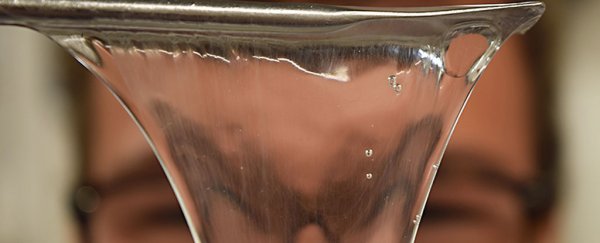A defence mechanism secreted by hagfish could be the key to developing super hydrogels for human use, scientists say.
Researchers in Switzerland have been studying the Atlantic hagfish (Myxine glutinosa), and specifically the slimy material it secretes when attacked by a predator. The slime, an extremely soft and elastic hydrogel, might not look dangerous in the image above, but it can be lethal to sea creatures.
When secreted in water from the glands of an agitated hagfish, the defensive liquid gels together with tiny fibres in a split second, creating a slimy mass to protect the hagfish. The slime forms a thick, viscous network that can immobilising the surrounding water and suffocate potential threats.
When Simon Kuster, a researcher at ETH Zurich, saw footage of the remarkable slime on a TV documentary, he was immediately fascinated. Hydrogels are a form of super-absorbent polymer with a hydrophilic molecular structure, which means they can hold large amounts of water. They're of great interest to scientists for their use in fields such as tissue engineering, drug delivery, and biosensors, among other applications.
"As a chemist and material scientist, I couldn't help but wonder what this slime consists of and what factors allow it to immobilise such enormous amounts of water," he said.
Kuster set about examining the natural hydrogel to see what makes it so dangerously slimy. The gel is composed of two elements: long protein threads measuring 15-to–30 centimetres (6-to–12 inches) in length, and mucin, a protein constituent of mucus.
The protein threads are much like spider thread, being extremely tear-resistant and moist. When the threads and mucin are released into seawater, they form a matrix that absorbs and immobilises water and solids in the immediate area.
To study hagfish slime, the Kuster and his team travelled to Norway, where a research partner was authorised to catch hagfish in the wild and keep them in an aquarium. While research back at their facilities would be more sophisticated, ferrying the animals back home was not an option.
"The transport would stress the hagfish too much," said Lukas Böcker, one of the team. "They would secrete slime throughout the journey and eventually suffocate in their own slime."
The researchers' preliminary analysis of the slime, reported in ACS Biomaterials Science & Engineering, details how they found a way to stabilise the glandular secretion using negatively charged biopolymers to form fibre-enforced hydrogels. Without this, the hydrogel eventually collapses in seawater.
Exactly how the stabilisation functions is not yet clear, but the researchers aim to figure this out in subsequent research. If they can discover how the slime formation manages to absorb so much water so quickly, it might be the key to developing super hydrogels that could be used in everything from disposable nappies to farming irrigation systems.
It's likely that any such human-made hydrogel will not be an exact imitation of the hagfish slime, but rather a gel that mimics the principles of the natural hydrogel.
"We cannot copy the slime formation mechanism of the hagfish in the laboratory," said one of the researchers, Lukas Böni. "This natural system is far too complex."
